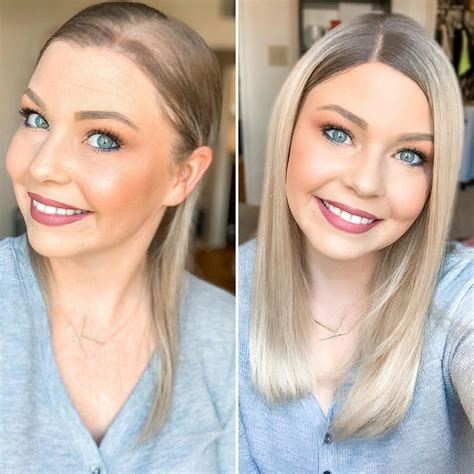What is a Hair Topper?
A hair topper is a non-surgical solution for adding volume, length, or coverage to thinning or balding hair. It resembles a small wig that clips in place, providing a natural-looking boost to your existing hair.

Types of Hair Toppers
1. Volume Toppers: Enhance volume at the crown or part line, creating a fuller, more youthful appearance.
2. Length Toppers: Add length from the mid-shaft to the ends, creating stylish and versatile hairstyles.
3. Coverage Toppers: Conceal sparse areas or hair loss by providing full coverage, restoring confidence and self-esteem.
Benefits of Using Hair Toppers
1. Instant Volume and Length: Get the desired fullness and length you crave without waiting for your hair to grow.
2. Conceal Hair Loss: Hide thinning areas or bald spots discreetly and effectively.
3. Versatile Styling: Style hair toppers with your natural hair to create endless looks, from buns to braids.
4. Non-Surgical Option: Avoid the risks and recovery time associated with surgical hair loss treatments.
5. Boost Confidence: Regain a fuller head of hair, enhancing your self-image and confidence.
Choosing the Right Hair Topper
1. Match Your Natural Hair: Select a topper that matches your hair color, texture, and style for a seamless blend.
2. Consider Your Hair Type: Choose a topper base type that suits your hair needs, such as monofilament for sensitive skin or polyurethane for durability.
3. Determine Your Coverage Level: Select a topper that provides the desired coverage, from partial to full.
4. Choose a Comfortable Fit: Ensure the topper fits securely and comfortably, allowing you to move naturally.
Tips and Tricks
1. Prep Your Natural Hair: Use root lifting products to create volume and a better hold for the topper.
2. Secure the Topper: Clip or hook the topper in firmly, starting at the front and working backward.
3. Blend the Edges: Use a teasing brush or blending scissors to seamlessly integrate the topper with your natural hair.
4. Style as Desired: Style your topper and natural hair together, using products that enhance volume and definition.
5. Remove and Care: Carefully remove the topper before bed and brush it gently to maintain its shape.
Why Hair Toppers Matter
1. Self-Expression: Hair toppers empower women to regain their self-confidence and feel beautiful.
2. Social Impact: Studies show that hair loss can lead to social isolation and depression. Hair toppers reduce these negative effects.
3. Health and Well-being: Hair loss is often a symptom of underlying health conditions. Hair toppers provide a discreet solution while promoting overall well-being.
Pros and Cons of Hair Toppers
Pros:
- Instant hair transformation
- Non-surgical and non-invasive
- Conceals hair loss effectively
- Versatile styling options
- Boost in confidence and self-esteem
Cons:
- Can be expensive
- Requires maintenance and care
- May not be suitable for all types of hair loss
- Can be noticeable if not properly applied
Applications of Hair Toppers
1. Coverage for Androgenic Alopecia: Hide the thinning hair caused by a hormonal condition that primarily affects women after menopause.
2. Volume Enhancement for Fine Hair: Add volume to fine or thinning hair, creating a fuller, more youthful appearance.
3. Concealment of Surgical Scars: Cover surgical scars on the scalp after medical procedures or hair transplants.
4. Transitioning from Hair Loss Medications: Provide temporary coverage while waiting for the effects of hair loss medications to take hold.
5. Temporary Volume and Style: Achieve desired volume and style for special occasions or photo shoots without permanent alterations.
Statistics on Hair Loss
- 50% of women experience hair loss at some point in their lives.
- Androgenic alopecia affects 30-50% of postmenopausal women.
- Hair loss is the third leading cause of cosmetic concerns in women, after wrinkles and acne.
Table 1: Types of Hair Topper Bases
| Base Type | Advantages | Disadvantages |
|---|---|---|
| Monofilament | Natural look, Breathable | Delicate, Requires special care |
| Polyurethane | Durable, Secure | Can be less breathable, May cause skin irritation |
| Silicone | Flexible, Comfortable | Can be less breathable, Not as durable |
Table 2: Hair Topper Coverage Levels
| Coverage Level | Description | Benefits |
|---|---|---|
| Partial | Covers specific thinning areas or adds volume | Less noticeable, Can be styled with natural hair |
| Full | Provides complete coverage | Hides all hair loss, May require more maintenance |
| Crown | Adds volume and coverage at the crown | Ideal for concealing thinning at the part line |
Table 3: Tips for Applying a Hair Topper
| Step | Instructions |
|---|---|
| 1 | Prep natural hair |
| 2 | Clip in the topper |
| 3 | Blend the edges |
| 4 | Style as desired |
Table 4: Caring for a Hair Topper
| Maintenance Task | Frequency | Instructions |
|---|---|---|
| Brushing | Daily | Gently brush with a soft brush to remove tangles. |
| Washing | Weekly or bi-weekly | Use a gentle shampoo and conditioner specifically designed for hair toppers. |
| Conditioner | After each wash | Apply a moisturizing conditioner to keep the hair soft and manageable. |
| Styling | As needed | Use styling products that enhance volume and support the topper’s shape. |
